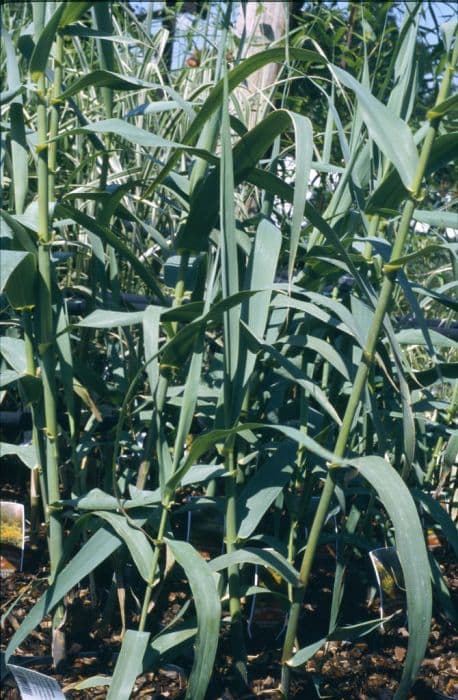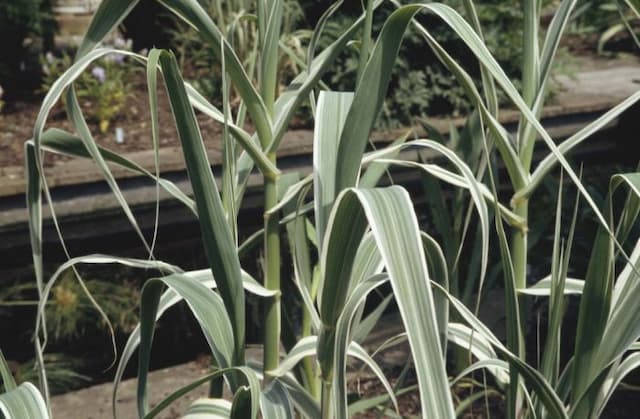Feather Grass Stipa calamagrostis 'Lemperg'

ABOUT
The plant known as Feather Grass 'Lemperg' features slender, arching leaves that create a flowing, fountain-like mound. Its foliage exhibits a green color during the growing season, turning into a beautiful golden hue as the seasons shift toward autumn. The plant stands out with its exquisite silvery inflorescences that emerge in summer. These delicate flower plumes catch the light and can add a soft, ethereal quality to any landscape. As they mature, the flowers take on a golden color, providing visual interest well into the winter. This ornamental grass is appreciated for its graceful form and the way it sways with even the slightest breeze, adding movement and a fine texture to gardens.
About this plant
 Names
NamesFamily
Poaceae
Synonyms
Lemperg Feather Grass, Lemperg Needle Grass
Common names
Stipa calamagrostis 'Lemperg'.
 Toxicity
ToxicityTo humans
The Feather grass is not commonly known to be toxic to humans. However, as with many ornamental plants, it is generally not intended for ingestion. If any part of the plant is ingested by mistake, it could potentially cause mechanical irritation or discomfort due to the sharp edges of the grass blades, but significant toxic effects are unlikely.
To pets
The Feather grass is not commonly recognized as a toxic plant to pets. Nevertheless, ingestion of plant parts, particularly the grass blades, could lead to mechanical irritation of the mouth or digestive tract. There might be a risk of impaction or gastrointestinal discomfort, but there are no specific toxic compounds in Feather grass known to cause poisoning in pets.
 Characteristics
CharacteristicsLife cycle
Perennials
Foliage type
Deciduous
Color of leaves
Green
Flower color
Varies
Height
3 feet (0.91 meters)
Spread
2 feet (0.61 meters)
Plant type
Grass
Hardiness zones
5
Native area
Eurasia
Benefits
 General Benefits
General Benefits- Ornamental Value: The plant adds aesthetic appeal to gardens with its fine-textured foliage and graceful, feathery plumes.
- Drought Tolerance: Once established, it can survive with minimal watering, making it suitable for xeriscaping or dry climate gardens.
- Erosion Control: Its dense growth habit and deep root system can help stabilize soil and prevent erosion.
- Low Maintenance: It requires minimal care beyond the occasional trimming to remove spent plumes or tidy up the plant.
- Wildlife Attraction: The feathery seed heads can attract birds, which use them for building nests or as a food source.
- Seasonal Interest: Provides visual interest throughout the seasons, from green growth in spring to golden hues in fall and tawny seed heads in winter.
- Adaptability: It can grow in a variety of soil types, from well-drained to clay soils, though it prefers a sunny location.
 Medical Properties
Medical PropertiesThis plant is not used for medical purposes.
 Air-purifying Qualities
Air-purifying QualitiesThis plant is not specifically known for air purifying qualities.
 Other Uses
Other Uses- Stipa calamagrostis 'Lemperg', commonly known as Feather Grass, can be used in creating dried floral arrangements for long-lasting, aesthetically pleasing decorations that require minimal maintenance.
- Feather Grass can be implemented in sound barrier vegetation strips alongside highways or railways to help reduce noise pollution due to its dense growth habit.
- The plant's elegant form and movement in the breeze make it ideal for use in calming and meditative garden spaces, contributing to psychological well-being.
- The texture and color of Feather Grass provide excellent contrast when planted in photographic or film set designs, offering a natural and rustic backdrop.
- Feather Grass can be used in erosion control projects, particularly on slopes or banks, thanks to its root system that helps stabilize the soil.
- The seeds of Feather Grass may be used for bird feed in garden settings, particularly attracting seed-eating songbirds that contribute to the local ecosystem.
- Feather Grass can be used as a natural mulch once it's cut down, providing soil moisture retention and temperature regulation benefits.
- Its tall and flowing appearance makes it an excellent option for creating garden borders that provide a soft separation between different garden areas.
- Feather Grass is useful in creating tactile experiences in gardens for the visually impaired, as it is soft to touch and safe to handle.
- In landscape art, Feather Grass can be incorporated as a living sculpture element, taking advantage of its form to create dynamic pieces that change with the wind.
Interesting Facts
 Feng Shui
Feng ShuiStipa calamagrostis is not used in Feng Shui practice.
 Zodiac Sign Compitability
Zodiac Sign CompitabilityStipa calamagrostis is not used in astrology practice.
 Plant Symbolism
Plant Symbolism- Resilience and Adaptability: As a grass species, the Feather Grass symbolizes the ability to adapt and thrive even in challenging environments, much like how it stands firm and flexible against the wind.
- Elegance and Grace: The delicate and feathery plumes of the Feather Grass represent a sense of finesse and elegance, which can symbolize an appreciation for the finer things in life or a graceful demeanor in a person.
- Freedom and Lightness: The way Feather Grass sways lightly in the breeze can be associated with a feeling of freedom and lightness, reminding us of the ease with which one can move through life's challenges.
- Simplicity and Minimalism: Feather Grass, with its simple and unassuming appearance, can symbolize the value of simplicity and the idea that there is beauty in minimalism and not overcomplicating things.
- Longevity and Perseverance: Many grasses, Feather Grass included, are perennials, which return year after year. This can symbolize longevity and the perseverance to withstand the test of time.
 Water
WaterThe Feather Grass prefers a moderate watering regimen where you water it deeply but infrequently to encourage deep root growth. It should be watered once every week or two, providing approximately 1 inch of water each time. During the hot summer months, if there is no rainfall, you may need to water every week. In contrast, the watering frequency should be reduced during cooler months or periods of rainfall, potentially extending to once every two or three weeks. Make sure the soil is well-drained, as Feather Grass does not tolerate soggy conditions. In terms of a fixed amount of time, aim for about half a gallon per square foot every month during the growing season.
 Light
LightFeather Grass thrives best in full sun conditions. It requires a minimum of 6 hours of direct sunlight each day, making a spot that receives unfiltered sunlight for most of the day ideal. Avoid planting in heavy shade, as this can lead to reduced vigor and fewer blooms.
 Temperature
TemperatureFeather Grass is hardy and can survive temperature fluctuations; however, the ideal growing conditions would be between 60°F and 75°F. It can tolerate a little frost and survive minimum temperatures down to about -20°F, but extended periods below this may damage the plant. During the hot summer months where temperatures exceed 80°F, the plant will still grow but may require additional watering to stay healthy.
 Pruning
PruningPrune Feather Grass in late winter or early spring before new growth begins. This helps to remove dead foliage and allows the plant to focus energy on new growth, promoting a healthier and more aesthetically pleasing form. Pruning should be done once a year, cutting back the old foliage to about 4-5 inches above the ground to make way for new shoots.
 Cleaning
CleaningAs needed
 Soil
SoilThe Silver Feather Grass prefers well-drained soil with a slightly acidic to neutral pH, ranging from 5.8 to 7.0. A good soil mix for this grass might include loamy soil, coarse sand, and organic matter, like compost, to improve drainage and provide nutrients. It is important to avoid waterlogged conditions which can lead to root rot.
 Repotting
RepottingSilver Feather Grass does not typically require frequent repotting. This perennial grass prefers to be left undisturbed, and repotting is usually only necessary when it has outgrown its current container or the soil has become exhausted. Generally, it can be repotted every 2-3 years or when you see signs of roots emerging from the bottom of the pot.
 Humidity & Misting
Humidity & MistingSilver Feather Grass is tolerant of a range of humidity levels and does not require any special humidity adjustments. It grows well in the average ambient humidity found outdoors. For indoor growing, normal household humidity levels are usually adequate without the need for additional humidification.
 Suitable locations
Suitable locationsIndoor
Place in bright indirect light and ensure good airflow.
Outdoor
Plant in sunny spot, protect from strong winds, minimal care.
Hardiness zone
4-9 USDA
 Life cycle
Life cycleStipa calamagrostis 'Lemperg', commonly known as feather grass, begins its life cycle as a seed that germinates in favorable conditions of light and moisture, typically in late winter to early spring. The seedling stage follows, where the young plant establishes its root system and begins to grow its characteristic narrow leaves. As it matures into its vegetative stage, feather grass develops dense tufts of foliage and becomes established in its growing location. The reproductive stage occurs in late spring to early summer when it sends up tall, feathery flowering stalks that sway attractively with the breeze. After pollination, the plant sets seed, which disseminates by wind, allowing for the natural propagation of new plants. The plant may then enter a period of dormancy during cold weather, only to recommence its life cycle with the return of warmer temperatures.
 Propogation
PropogationPropogation time
Spring-Early Summer
The most popular method of propagation for the Stipa calamagrostis 'Lemperg', commonly known as Feather Grass, is through seed sowing. Seed sowing can be carried out in the spring, around the last frost date, when the soil temperature is mildly warm. To propagate Feather Grass from seeds, prepare a well-draining soil mix in a container and scatter the seeds lightly over the surface. A light covering of soil can then be applied, as seeds require some light for germination. Water the seeds gently to moisten the soil without causing the seeds to dislodge. Keep the soil consistently moist but not waterlogged. Seedlings should emerge within a few weeks, depending on the temperature and growing conditions. Once they have grown large enough to handle, the young plants can be thinned out and eventually transplanted to their desired location in the garden.









